
- Homepage
- Artist
- Abraham Palatnik (4)
- Achtziger (19)
- Alexander Danel (8)
- Anime (6)
- Frankart (7)
- Gyula Jakab (5)
- Jim Shore (5)
- Jmw Chrzanoska (7)
- Kaj Franck (4)
- Lenox (6)
- Lorna Bailey (7)
- Louis Icart (8)
- Margaret Keane (4)
- Mark Kazav (17)
- Mark Kazav, M.kazav (9)
- Steuben (7)
- Tamila Svirska (71)
- Tiot (4)
- Unknown (65)
- Unsure (4)
- Other (3357)
- Department
- Item Length
- Signed By
- Alan Moore (3)
- Artist (12)
- Carl Scheidig (2)
- Frances Burton (2)
- Gyula Jakab (4)
- Herend (9)
- Jaline (2)
- Kitty Riley (2)
- Lalique (10)
- Mark Kazav (18)
- Michael Dalton (2)
- No Name (2)
- R.benedikt (6)
- Rene Lalique (4)
- Signature Unreadable (13)
- Steuben (7)
- Sven Palmquist (2)
- Unsigned (4)
- Various Artist (2)
- Veronese (3)
- Other (3515)
- Size
- 1 / 6th 30cm (7)
- 1 / 6th 40cm (4)
- 11oz (2)
- 4 1 / 4\ (2)
- 48x32 (7)
- 6.3 Inch (10)
- 7 3 / 4 Inches High (2)
- 9-1 / 2 Tall (3)
- Large (85)
- Large (up To 60in.) (14)
- Medium (360)
- Medium (up To 36in.) (90)
- Mini (2)
- Mini (up To 6in.) (6)
- Miniature (5)
- Queen (2)
- See Description (26)
- Small (147)
- Small (up To 12in.) (34)
- Other (2816)
- Style
- 1940s (6)
- Abstract (12)
- Abstract, Art Deco (11)
- Art Deco (1693)
- Art Deco Style (16)
- Art Déco (10)
- Art Nouveau (14)
- Cat Eye (166)
- Contemporary (9)
- Cuff (5)
- Egyptian (6)
- Figural (5)
- Mid-century Modern (23)
- Modern (5)
- Modernism (6)
- Moroccan (8)
- Pendant (6)
- Realism (6)
- Vienna (12)
- Vintage (6)
- Other (1599)
FINE Important Art Deco Chinese Woman Panther Cat Bronze Sculpture TIEFENG
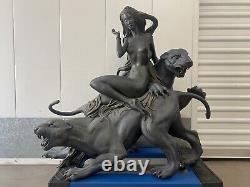
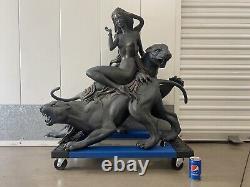
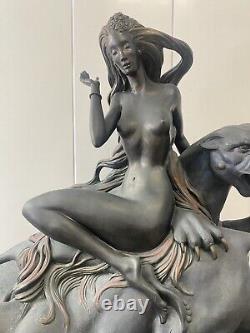
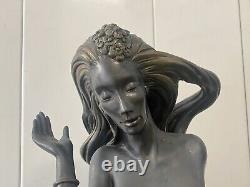


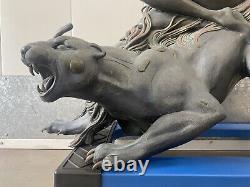

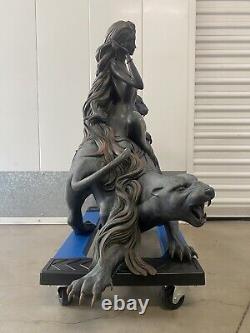
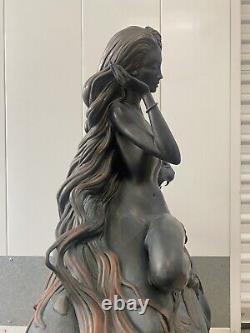

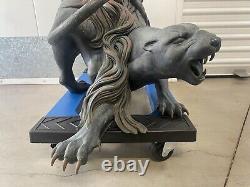
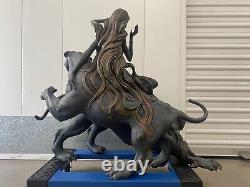

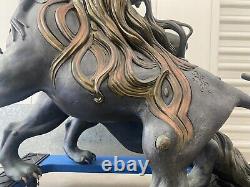
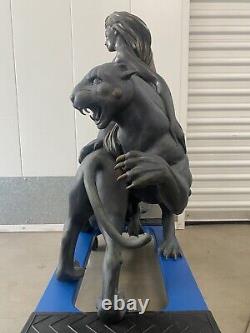

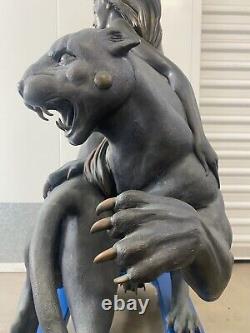








This is a phenomenal and FINE Important Art Deco Chinese Woman Panther Cat Bronze Sculpture, by renowned Chinese Modernist painter, sculptor, and original founder of the Yunnan Modern Art Movement, Jiang Tiefeng b. This sculpture is titled " Mountain Ghost, " and dates to 1989. THIS ITEM YOU ARE SEEING IS NOT THAT. This masterful and huge (1/3) life-sized sculpture depicts the fantastical portrait of a young maiden astride a wild black panther. She wears flowers in her hair, and blissfully looks outward toward the viewer, with her very long mane flowing downward. A large black panther on her left can be seen raising its left arm, in a ferocious and statuesque stance. The artist's photorealistic rendering of the panther's tendons, fur and extended claws are a sight to behold. I cannot begin to describe how incredible this sculpture is, so I took very good pictures of this piece, so that you may see the masterful finesse of this artist and his work for yourself. Annotated and numbered on the belly of the panther, on the verso: FINGERHUT'89 17/30. Additionally, this piece is hand signed in the original casting with the artist's Mandarin Chinese signature on the rump of the large wildcat, visible on the verso. Approximately 33 inches tall x 39 inches wide x 25 inches deep. Good condition for age and decades of display use, with some mild scuffing, oxidation and moderate - heavy gilding loss in some places please see photos carefully. This sculpture easily weighs 100 - 150 lbs. At least and appears to be solid bronze.
One person cannot move it on their own. Acquired from the private collection of a well-known deceased Orange County tech executive. If you like what you see, I encourage you to make an Offer.
Please check out my other listings for more wonderful and unique artworks! About this Artwork (from Jean Stephens Galleries).
Mountain Ghost (1/3 Life Size). 33" H x 39" W x 25 D. Spotlight On Fingerhut Group Publishers. Fingerhut Group Publishers got its start in the 1970s with the work of artist Jiang Tiefeng. Today, the company represents several artists, including newly signed artists Colleen Ross, Gwen Peine Toomalatai, Daniel Acebo and Sergey Smirnov.
The company also owns a string of successful California galleries in Carmel, Laguna Beach, La Jolla and Sausalito. For Fingerhut Group Publishers, publisher of Chinese artist Jiang Tiefeng among others, the artists are at the heart of the business. And business is indeed booming with the recent addition of four new artists to the mix. Colleen Ross, Gwen Peine Toomalatai, Daniel Acebo and Sergey Smirnov have been signed to the company.Allan Fingerhut couldn't be more pleased with the newest members of the family and the timing of their addition during a period of what he sees as unlimited potential comparable to the art boom of the'80s. I think in a few months, things are going to be very strong. It's very logical that our particular business will be very strong in the future.
That's why I'm pioneering new artists, he said. Ross' art has been coined "Glam Pop" for its mix of early Hollywood, comic books,'30s deco,'40s pin-ups and'60s Pop Art. Her work has been featured in galleries worldwide and is in the collections of such Hollywood stars as Teri Hatcher, George Lucas and Nicholas Cage. Toomalatai said her paintings are a reflection of my own journey in life and the lessons I've experienced up to this point. She creates her distinctive look using birch plywood and several layers of oil, paint and glaze.
Sculptor Daniel Acebo's bronze multiple sculptures are drawn from nature and he seeks to exemplify the essence of the animal in motion. Russian artist Smirnov, an expert in icon and fresco restoration and an award-winning designer, utilizes a style that echos his favorite period of Russian art known as parsuna. The work bridges the worlds of religious and personal portraiture. He's exhibited in the Kremlin's "Manezh, " and his work is in the collections of former president Boris Yeltsin and other key governmental figures.
These four artists are just a few of the artists represented by Fingerhut Group Publishers. They then started a gallery in Minneapolis and signed Jiang in the early'80s. Due to Jiang's success in the galleries, the Fingerhuts decided to publish his work. "We went on the road for three months and came back with 30 galleries that got on the program, " said Fingerhut.
Today, the company is based in California and runs successful Fingerhut Galleries out of Carmel, Laguna Beach, La Jolla and Sausalito, Calif. The galleries carry an extensive collection of works by the company's published artists, master artists and today's emerging artists as well as featuring works by Rembrandt, Matisse, Picasso, Miro, Peter Max, Chagall, Wilkinson, Vanderveen, Markus, Dr. The publishing wing serves the needs of more than 200 fine art galleries in the United States, Canada and Japan. In addition to the new signees, the company's artists range from the romantic, sensual interiors of Polish-born painter Joanna Zjawinska to the landscapes of Barbara McCann to the intense vision of Jiang.
JIANG TIE-FENG, CHINESE (1938 -). Chinese Artist Jiang Tie-Feng was born in 1938, in Ningbo, Zhejiiang Province, in China. Even as a child he displayed a great love and talent for painting and drawing, and early on he knew the course his life would take. A colorist, Jiang's intention was to reverse the trend of the stale Chinese tradition of painting in gray, black, and white. Jiang says: Chinese art had reached a sick level due to its lack of color.
Jiang's colors are of unsurpassed richness. Jiang Tie-Feng is a storyteller. His paintings are steeped in Buddhist and Chinese mythology. Each figure has a symbolic meaning.
The paintings have so much complexity and visual fascination that the viewer is constantly seeing something new. Jiang says For every picture there is a story, and for every story there is a picture.
Jiang's vision has continued to grow and expand. Probably because of his personal experience in two cultures he has increasingly seen the world as a single system, as a meeting place of diverse forces. The founder of the Yunan School of Art, Jiang Tie-Feng is clearly the leading exponent of art in China today. Jiang Tiefeng is a painter, sculptor and author. Jiang Tiefeng artist is one among the 100 most popular artists in the world.
His paintings are not only rich in color but also rich in meaning and life. Came at a time when China was known to produce black, gray and white paintings. He believed that the early paintings in China had escalated to a sick level and looked dull due to their lack of color. The unsurpassed color in all his prints has been the main reason why most art galleries are never complete without a touch of his art.Born in 1938, in Zheijiang Province, China, Jiang Tiefeng artist has traversed the olden art and the contemporary paintings and sculptures. He realized his art passion as a child, evident by his love for drawings and paintings.
Later on, he knew what he wanted to be in life and he pursued his passion to be among the most powerful artists in this generation. Like mentioned above, he wanted to reverse the tradition of painting in dull colors by adding color to all his PAINTINGS. His use of imagery is impressive. He believes that behind each piece of art he does there is a story and behind each story there is a piece of art. Most of his paintings have a touch of Chinese and Buddhist mythology as he believes every painting must communicate to the people who see it.
Each of the art has a symbolic meaning. Jiang Tiefeng limited editions and themes are universal today. All his paintings depict fertility, motherly love, strength and primordial human emotions. He believes that all living things have a connection and are bonded together through harmony and peace that each of us struggle to maintain.
Jiang Tiefeng Sculpture and painting pieces of art show complexity and elegance that the viewers are always seeing unique things. His vision in the art arena has continued to expand each day while his experience in the two cultures has enabled him view the world as a single system and a meeting place for varied forces.
His journey as an artist has not been a smooth one. After graduating from the Central Art Institute, he was forced to create propaganda sculptures and posters which meant severe punishment for him if he was caught. He worked in his house at night with two other artists. It is during this period that he realized the painting style he uses today. After the saga, Jiang started the Yunnan School of Painting.
The school featured the use of heavy and bold colors coupled with abstract imagery. Jiang incorporated symbols in his work to represent the custom and the forklore of the Yunnan residents.
His 1980 monumental mural is still installed in Beijing at the Great Hall of the People. He later moved permanently to America in 1984. Jiang Tiefeng art for sale has been a topic in many galleries where his art is being exhibited. He is well known in Asia, Europe, America, Australia and even Europe.My paintings are not only pictures; they are also music and poetry that is bewitching, sweet dreams that are being dreamed. Born in Zhejiang Province, China, Jiang discovered his love of art through painting and drawing during his early childhood. After winning admission to the Central Academy of Fine Arts in Beijing, Jiang earned a Bachelor of Arts degree in 1964, just before the beginning of the Cultural Revolution.
On completion of his studies Jiang volunteered to visit the lush and tropical Yunnan province on the Vietnamese border. This visit to such an exotic landscape was to prove a lifelong influence on Jiang's work. The Chinese government also recognised Jiang's talent and forced him to produce propaganda posters and sculptures as part of the Cultural Revolution, including the iconic red faced poster of Chairman Mao. At night though, Jiang was inspired by the natural beauty of the Yunnan province and he developed a style of his own. He was particularly focused on bringing colour to his art and, using the influence of Chinese mythology and Buddhism, he created pieces with great symbolic meaning.
He and two other artists, He Neng and Liu Shaohui, secretly founded the "Yunnan School" where the use of bold colour and imagery was embedded in the teachings. Jiang's career was able to thrive, even under the harsh realities of the Cultural Revolution. In 1979 he was commissioned by the Chinese government to paint a mural representing the Yunnan province for the Great Hall of the People in Beijing. Jiang also illustrated children's books and cartoons. Ultimately though, Jiang's work fell out of favour with the communist government. During 1982 a National Geographic reporter writing an article on life in China saw Jiang's paintings. A selection was smuggled out of China, folded up in a National Geographic magazine, and brought back to the U.Were they received high praise. Jiang permanently emigrated to the U. In 1984 where his work has been shown in many public exhibitions including those at the Portland Museum in Virginia and the New England Centre of Contemporary Art. Symbolism in Jiang's Art. Birds: Birds represent the comings and goings of people.
They also represent anticipation, freedom and flight. Calla Lilies: The Calla Lily represents gentleness and purity.
Cherry Blossoms: White blossoms symbolise newness and infinite beginnings. Colour Circles: The colour circles floating throughout Jiang's work symbolise the notes of music. Cranes: The crane is an one of good luck, peace, prosperity, nobility and long life. Dragons: The dragon is the Son of Heaven - maintainer of harmony on earth and controller of weather and water. The dragon as an emblem is used exclusively by the Emperor. Elephants: Elephants symbolise good luck and fortune.Female Figures: Female figures represent fertility. They are Mother Earth, givers of life. Flutes: The lute is an instrument of love.
As the flute's song is heard, a lover will respond with his own song. Horses: The horse symbolises sped, strength, power and endurance.It is also a sign of good business. Pandas: Pandas symbolise innocence, simplicity and honesty.
Panthers: The black panther is a positive symbol. It symbolises power and grandeur, and is the reverent guardian of life. The Phoenix: The Phoenix is the most famous and revered bird in Chinese lore. It is a symbol of strength and of power and is used by the Empress and an emblem. Stones: Stones and rocks are the witness to eternity.
Tigers: The tiger is a symbol of strength and power. In older times the tiger was the symbol of the local chieftain.
Water: Water is the representation of time, and like time, can never flow against itself. Young Maidens: The young maiden is the universal symbol of goodness, beauty and purity.Jiang Tiefeng is the founder of the Yunnan School of Painting, one of the most important contemporary movements of abstract art in China. His works are richly colored and his imagery contains figurative elements with contrasting patterns. Considered to be at the forefront of contemporary Chinese art, Jiang paints as if creating stained glass windows, concentrating on women, horses, birds, and flowers through brightly colored ink and calligraphic lines.
Jiang attended the Central Academy of Fine Arts in Beijing. He studied with the renowned Chinese artist, Huang Yong-Yu. During the 1960s and early 1970s, Jiang was assigned to produce propaganda posters during Mao's Cultural Revolution. At night Jiang secretly worked on his own style. He works primarily in watercolor and serigraphy and his works have been actively collected worldwide since the early 1980s. From 1976 to 1983, Jiang served on the board of directors for the Yunnan branch of the Chinese National Art Association. He was also a member of the Chinese Woodblock Association. Later, Jiang was an instructor and professor at the Yunnan Art Institute. In 1979, he was commissioned by the government to paint a mural representing Yunnan Province which was installed in the Great Hall of the People in Beijing. 2008 Asia Society and Museum, New York, Shanghai Art Expo, Shanghai, China 2007 Hangzhou Grand Hall, Hangzhou, China Ningbo Art Gallery, Ningbo, China 2006 Hangzhou Stadium, Hangzhou, China 2002 Westlake International Exhibition of Fine Art, Hangzhou, China China International City Sculpture, Exhibition and Symposium, Beijing, China 1998 Liuhaisu Museum, Shanghai, China Guanshanyue Museum, Shenzhen, China, 1993 California Institute of Fine Arts, CA 1992 New England Center of Contemporary Art, CT 1990-1 Everson Museum, NY Springfield Art Museum, OH Michelson Reves Museum, TX Valdosta Museum at Valdosta State University, GA Art and Culture Center, FL, Olin Fine Art Center, PA 1989 Museum at Northeastern University, MA 1988 Connecticut College Art Gallery, CT 1987 Springfield Art Center, OH 1986 Portland Museum, VA 1985 New England Center of Contemporary Art, CT 1983 University of Southern California, CA International Exhibition of Illustration Children's Book, Italy 1982 No. 1 Art Design Institute, Hong Kong 1981 China Fine Arts Gallery, Beijing, China Tianjin Museum, Tianjin, China 1980 Yunnan Museum, Kunming, China 1979 The Great Hall of the People, Beijing, China 1974 Yunnan Museum, Kunming, China 1970 Yunnan Museum, Kunming, China. Jiang was born in 1938, in Ningbo, Zhejiiang Province, in China. In 1959, in a highly competitive exam he won admission to the prestigious Central Academy of Fine Arts in Beijing. From 1962-64 he studied with the famous Chinese artist Huang Yong-yu, who first exposed him to the paintings from the Dunguang caves. In 1964 he earned his Bachelor of Arts degree. This was the last class to graduate before the cultural revolution. Jiang also learned about traditional Chinese art, an influence which would remain with him. Upon graduation in 1964 Jiang and a small number of other artists volunteered to go down to the Yunnan province. This turned out to be a blessing. This beautiful province is on the Vietnamese border. It is lush and tropical, filled with exotic flora and fauna, and is home to more than 20 different minority peoples.His new home allowed his talents to burst forth. Jiang's talent was so obvious that from 1966-73 the Chinese Government assigned him to produce "Socialist Realism" propaganda posters and sculptures during the Cultural Revolution.
He even painted the famous large red-faced poster of Chairman Mao. But this sterile exercise did nothing to release the emotional side of Jiang's nature, and at night he worked in his small room, on his bed, to create his own style. The natural beauty of the Yunnan province inspired him.
With two other artists, He Neng and Liu Shaohui, Jiang secretly formed the nucleus of what was first called the "Heavy Colorist" school and is now known as the "Yunnan School, " began. The Progress of Jiang's Career. Jiang's work quickly gained prominence and even the repressive authorities had to concede his talent.He became one of the most well-known illustrators of children's books in China. In 1974 he illustrated Two Little Peacocks. In 1976 he designed the animated cartoon of the same book.
In 1978, Jiang began to teach as an Associate Professor at the Yunnan Art Academy, where he would continue until 1983. In 1979, the Chinese Government commissioned him to paint a mural representing Yunnan Province for the Great Hall of the People in Beijing. The project took seven months and used six full panels of silk. This was the "Stone Forest" mural, one of Jiang's finest works.
Jiang himself says: This mural was the first time I had ever let my own true style show publicly. The color, energy, and fantasy of my painting was not appreciated by the government during Mao's Cultural Revolution.
While I was painting "Stone Forest" an official came by and said I shouldn't do it that way. I said "Okay" as if I would change it.
But I didn't change a thing. Later he came back and said Oh, that's much better.
He didn't know what he was talking about. He was just comforted to think that he, a government official, had control over this strange, dangerous art. For Jiang, success followed success. In 1979 he illustrated "The Secret of Jinchun Tree, " which won the first prize as the best illustrated book out of Jiangsu Province.
His painting "The Legend of the Water Sprinkling Festival of the Dai" was featured in the documentary film Yunnan Scene. " In 1980 the illustrated books "Little Red Riding Hood"; "The Ugly Duckling"; and "A Shi Ma were published. For "A Shi Ma" Jiang was awarded Second Place in an international United Nations competition of illustrated books. In 1981, Jiang's work was featured in the "10 Artists From Yunnan" show in Beijing, and then, in 1982, was prominently featured at a show in Hong Kong, which also featured the Yunnan artists as well as some of their followers.
Government officials publicly stated that they feared China was losing its "socialist morality" and becoming morally polluted. Art officials favored a return to Socialist Realism painting and they expressed their displeasure by refusing to select paintings by Jiang, Liu Shaohai, or He Neng for the permanent collection of the National Art Gallery.
Jiang was the prime target of their wrath--his paintings were excluded from television coverage and a seminar was even officially organized to criticize his work. His work was criticized as... Liu Shaohai said that he would be glad to have nightmares every night if he could paint like that. The President of the Central Academy of Art and Design, Zhang Ding, wrote an article praising Jiang's work but withdrew it on the eve of its publication at his wife's urging, who remembered how Zhang Ding had been beaten and publicly humiliated during the Cultural Revolution.
Even so, Zhang Ding did on a number of occasions speak out and express his admiration for Jiang and some of the other young artists. All of this was making life increasingly difficult for Jiang. In 1982 a National Geographic reporter who was doing a story on China saw Jiang's paintings, and brought some back to the U. A friend of the reporter brought them to the Fingerhut Gallery in Minneapolis, where Jiang's work met with great success. Under the sponsorship of Allan Fingerhut, Jiang moved to Minnesota with his wife Zhaolin. For Jiang, success in America quickly followed. His rich, strong color, and exotic but intimate imagery struck an immediate response with the American public. Jiang's talent and uniqueness quickly brought his work to the attention of critics and museum curators nationwide, and this resulted in many public exhibitions. In 1984, Jiang had an exhibition at the University of Southern California Gallery; in 1985 at the New England Center of Contemporary Art in Connecticut; in 1986 at the Portland Museum in Virginia; in 1987 at the Springfield Art Center in Ohio; in 1988 at the Connecticut College Art Gallery; in 1989 at the Museum at Northwestern University in Massachusetts; and in 1990-91 at the Everson Museum in New York; the Springfield Art Museum in Ohio; the Michelson Reeves Museum in Texas; the Valdosta Museum at Valdosta State University in Georgia; the Art & Cultural Center in Florida; and the Olin Fine Art Center in Pennsylvania. During this period Jiang also had 52 one-man gallery shows in cities all over the country.Modern Western influences played a part in the formation of the Yunnan school, but traditional Chinese art--such as the sculpture from the Han Dynasty 221 B. Played by far the most important role.
This method, invented by the ancient zen artists more than 1500 years ago, is the precursor of abstract expressionism. By flicking the paint of the end of the brush the artists could create a totally energized surface. This is precisely what Jackson Pollock rediscovered in the 1940s and 50s.
But the Chinese had always used this technique, and Jiang uses it masterfully. But the greatest Chinese influence was the art created in the Dunguang caves in central China.In 1907 European explorers rediscovered the Buddhist caves on the Ancient Silk Road that led from China through Persia and finally to the West. At Dunghuang, the last caravan stop with a plentiful amount of water and supplies before travelers from China ventured into the perilous Takla Makan desert, the explorers discovered a group of more than 400 caves with paintings of extraordinary quality which had been very well preserved by the dry desert climate. These paintings had been created over a period of 700 years, from roughly 300 to 1000 AD.
They were commissioned as devotional acts by pious Buddhists: warriors, princes, kings, merchants, peoples from all walks of life--created in the same spirit as were the Gothic cathedrals of Europe. But by the 12th century wars and other geopolitical forces caused the abandonment of the caves, and they lay forgotten until their rediscovery by the Europeans in the 20th century. In 1942, a well-known and respected traditional Chinese artist Zhang Daqian led an expedition to the caves. He spent 2 1/2 years studying and copying the astounding paintings there. When his work became available to other artists and scholars it caused great excitement, for just as African and Iberian art and the cave paintings of Lascaux had inspired and liberated Picasso, so the revelation of the free flowing qualities of line and form and the rich mythic traditions of the Dunguang cave paintings inspired and liberated the young Chinese artists.
Jiang was particularly moved by the colors, the linear quality, and the mythic stories of the cave painting--and we see this in his work. " Jiang's credo is: "Long live the Line! He is a genius at using line to give the illusion of depth to a flat two-dimensional surface--almost like an x-ray.Jiang's paintings are like cubism: by using superb drawing he creates transparency, and thus he reveals more than one level of reality in each painting. But above all, the cave art was an indigenous Chinese tradition, a tradition that gave the artists similar freedoms to those won by the artists in the west, but at the same time it was a tradition that the artists could freely pursue without fear of being accused of being Anti-Chinese. The traditional mythic themes and images, and the rhythmic flow of the cave art have found their way over and over again into paintings of Jiang and the other "Yunnan School" artists. The influence of the Dunguang imagery and style combined with European Cubist influences, such as the use of transparent washes of colors to allow for a multileveled view of reality, characterize Jiang's work to this day. Jiang would also incorporate many of these traditional Chinese folkloric images into his art.
What is the secret of Jiang's popularity? Jiang's use of imagery.As noted above, Jiang is a storyteller. This is reflected in the number of environmental and ecologic themes which have recently begun appearing in his work, notably in such pieces as "Nature Suite, " "Genesis, " "Lovers Trees, " and My World. The secret and essence of Jiang's work is best expressed by the artist himself. An artist is not a photographer; my work is my understanding of life.
It is difficult for me to remember what distances I have traveled, how many mountains I have climbed, how many rivers I have crossed, and how many villages I have passed through. I can only recall the countless joyous moments and hardships of the past years from the many pictures I have painted. My deep love of the colorful earth and for Xishuangbanna, a region of the Yunnan Province, has encouraged me to explore and create unceasingly. Such a mysterious land blessed with unique beauty offers innumerable subjects to be painted. My paintings are not only pictures: they are also music and poetry that is bewitching, sweet dreams that are being dreamed.
